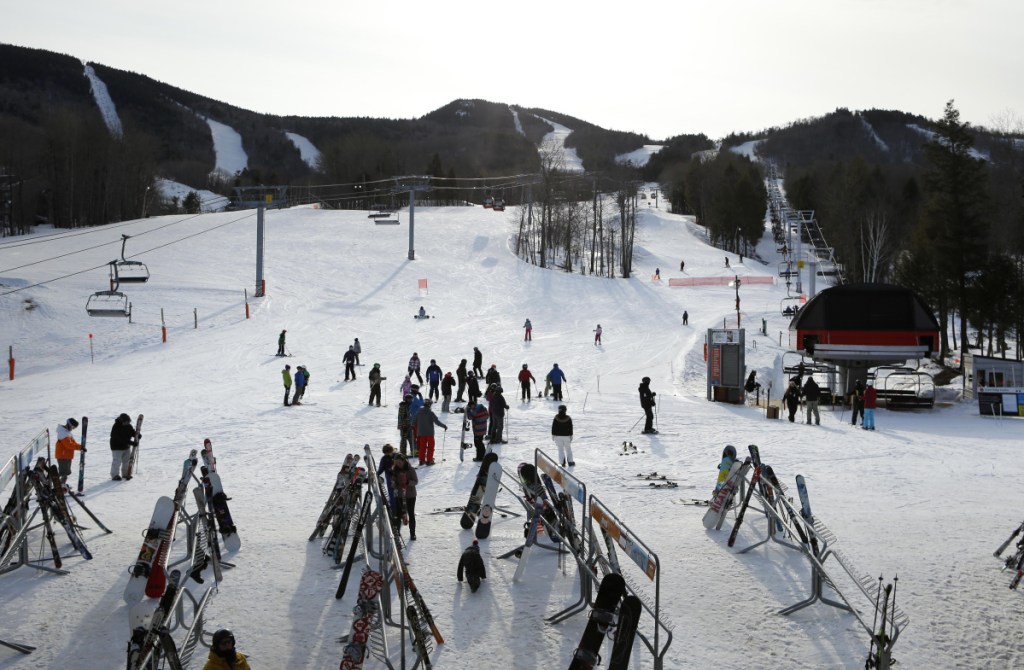In a high school physics class, desperate to squeeze some interest out of the topic, I wrote a paper about the “Physics of Skiing.”
In the clumsy prose of a 16-year-old, I outlined what happens when you make a turn on skis, or pop from one mogul to the next. With the help of gravity and by reducing friction as much as possible (through wax, aerodynamics and staying on edge), you convert potential energy into kinetic energy. You put your weight forward and on your downhill ski, and when you turn the middle of your ski bends while the tail and tip dig into the snow.
Simple, right?
The physics of skiing was on my mind last weekend while trying to teach a beginner how to move on skis. On the gentle slope of Sunday River’s Roadrunner, I couldn’t give a lick of advice without putting my skis on and slowly talking myself through it. I needed to ask myself aloud, “What exactly is my body doing when I ski? Where is my weight? Where are my hips and shoulders? If you’ve been skiing for 20 years, how do you turn … beyond just thinking the word turn?”
It didn’t always come to me so naturally. Being someone who makes some of his living talking about skiing, I’d like to pretend I came into the world skiing, the way a horse is born able to walk. But starting at age 10, I fumbled my way across the last 100 yards of Windjammer at the Camden Snow Bowl for the first time. Under lights illuminating dozens of beginning skiers, the rules of skiing came at us too fast and all at once. Stand upright. Lean forward. Weight on your downhill ski. Look uphill but keep your eyes a few turns ahead. Those ahead of you have the right of way, but yield to uphill skiers. All before I’d even ridden a lift.
Eventually the seemingly contradictory rules of the sport started to come into sharper focus. Like generations of Maine skiers, I can lay the blame for this firmly at the boots of the ski school, tireless (and underpaid) teachers who greet beginners with patience and generosity.
This feels particularly true of programs at small community hills like the Snow Bowl, Titcomb and a dozen others in Maine. A Mountain Riders Alliance survey found that 70 percent of skiers say they learned at places smaller than 1,600 vertical feet, and the accessibility and affordability of these mountains is what makes learning possible.
If you’ve ever seen the caravan of yellow school buses turning on Perkins Ridge Road into the Lost Valley parking lot on a weeknight, you know the role these “feeder mountains” play in the future of the sport.
The wonderful thing about expertise in a sport is how eventually all the rules transition from something you think about to second nature. For me, this started in high school. Skiing with a season’s pass for the first time and putting in 30-plus days a season, I moved from a competent-but-timid intermediate into a more confident, aggressive skier.
I credit this to a different kind of education: following skiers who were way better than I was, and a crew that was too bullheaded to turn back from any trail. Spending dozens of days charging down the King Pine bowl on Sugarloaf’s eastern boundary, I finally found myself just doing the sport rather than thinking about what I was doing.
Back in the early 1990s, psychologist Mihaly Csikszentmihalyi described the idea of “flow states” – a now popular description of joyous absorption, engagement and fulfillment (and, importantly, skill) in an activity so deep that nothing else seems to matter. While Csikszentmihalyi’s book “Flow” exploded the idea into popular consciousness, it’s something we skiers already knew. When you’re in a flow state, in the zone, or one with the mountain, everything else slips away. It takes years of fundamentals (thank you, ski schools), and years of practice (thank you, UM-Farmington), but the end result makes all the rules, yard sales and frostbite more than worth it.
A few days after my brief, ill-advised attempt at teaching, I tried to reconcile those early days on skis – and the physics of the sport – with the second nature senses of someone who fantasizes about skiing more than is advisable.
There’s the pressure of the chair on the back of my thighs, pushing off at the top station of the King Pine Chair. Dropping onto Widowmaker, my weight rolls under me, onto the edge of my downhill ski. My shins press against the tongues of my boots, pushing myself forward.
Time seems to stretch as my body drops toward the hill and my legs swing from me, carving into corduroy. I realign. My skis are back under me and I’m briefly weightless as I pop out of that turn and into another, my weight and balance a mirror of what it was a moment before. Wind whips at my face and frigid air fills my lungs. Repeat. Repeat. Repeat.
Josh Christie is a freelance writer living in Portland. Along with his brother, Jake, he writes about great Maine destinations for outdoors enthusiasts. Josh can be reached at::
joshua.j.christie@gmail.com
Copy the Story LinkSend questions/comments to the editors.



Success. Please wait for the page to reload. If the page does not reload within 5 seconds, please refresh the page.
Enter your email and password to access comments.
Hi, to comment on stories you must . This profile is in addition to your subscription and website login.
Already have a commenting profile? .
Invalid username/password.
Please check your email to confirm and complete your registration.
Only subscribers are eligible to post comments. Please subscribe or login first for digital access. Here’s why.
Use the form below to reset your password. When you've submitted your account email, we will send an email with a reset code.